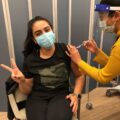Testosterone is a hormone produced by the human body. It’s mainly produced in men by the testicles. Testosterone affects a man’s appearance and sexual development. It stimulates sperm production as well as a man’s sex drive. It also helps build muscle and bone mass.
Testosterone production typically decreases with age. According to the American Urological Association, about 2 out of 10 men older than 60 years have low testosterone. That increases slightly to 3 out of 10 men in their 70s and 80s.
Men can experience a range of symptoms if testosterone decreases more than it should. Low testosterone, or low T, is diagnosed when levels fall below 300 nanograms per deciliter (ng/dL). A normal range is typically 300 to 1,000 ng/dL, according to the Food and Drug Administration. A blood test called a serum testosterone test is used to determine your level of circulating testosterone. A range of symptoms can occur if testosterone production drastically drops below normal.
Testosterone injections are most often given by your doctor. The injection site is typically in the gluteal muscles in the buttocks. However, your doctor may allow you to self-administer the injections. In that case, the injection site would be in your thigh muscles.
How To Inject Testosterone In Buttocks and Thighs
According to Tulane Urology doctors, here is how to self administer a testosterone injection:
Identify the concentration of your testosterone. Testosterone for injection is usually in the form of testosterone cypionate. These liquids come in multiple concentrations, so before giving an injection, it’s very important to make sure that your intended dosage takes into account the concentration of the testosterone serum. Usually, testosterone comes in a concentration of either 100 mg/ml or 200 mg/ml.
Use a sterile, suitable needle and syringe. As with all injections, it’s important to use a sterile, never-before-used needle when administering testosterone.
Another item to consider is the fact that testosterone is fairly viscous and oily compared to other injectable medications. Because of this, you’ll want to use a slightly thicker-bore needle than normal (for instance, a 20 or 21-gauge) to draw up your dose.
Wash your hands. To reduce the risk of infection, it’s important to keep your hands clean when giving an injection. Wash your hands thoroughly with antibacterial soap and water.
Draw up a dose. Your doctor will have given you a recommended dose – determine the volume of your dose in relation to the concentration of your testosterone. For instance, if your doctor recommends a dose of 100 mg, you’ll want 1 ml of a 100 mg/ml testosterone solution or ½ ml of a 200 mg/ml solution. To draw up your dose, first draw air into your syringe equal to the volume of your dosage. Then, wipe the top of the medication bottle with an alcohol wipe, insert your needle through the lid and into the medication, and push the air from your syringe into the bottle. Turn the bottle upside down and draw out the exact dosage of testosterone.
Injecting air into the bottle raises its internal air pressure, making it easier to draw the medication into the syringe. This is especially important with testosterone, which can be difficult to draw because it’s so thick.
Aspirate the syringe. Injecting air bubbles into a person’s body can cause a serious medical condition called an embolism. Because of this, it’s very important to ensure there are no air bubbles in the syringe when you inject the testosterone. Do this via a process called aspiration. See below for instructions:
Hold the syringe with its needle uncapped and pointing up in front of you.
Look for air bubbles in the syringe. Flick the side of the syringe to get these bubbles to rise to the top.
When your dosage is bubble-free, slowly depress the plunger to force the air at the top of the syringe out. Stop when you see a tiny drop of medication come out of the tip of the syringe. Be careful not to squirt or spray a significant portion of your dosage onto the floor.
Prepare the injection site. Testosterone injections are typically intramuscular – that is, given directly into a muscle. Two relatively easy and accessible sites for intramuscular injection are the deltoid (upper arm) or the glut (upper back portion of the thigh, ie, the butt cheek). These aren’t the only places that testosterone can be injected, but they are by far the most common. Whichever of these sites you choose, take a sterile alcohol pad and wipe the immediate area around where you intend to inject. This will kill bacteria on the skin, preventing infection.
If injecting into the glute or buttocks, choose an injection site in the top outside section of the glute. In other words, pick a site either in the top left corner of the left glute or the top right corner of the right glute. These site have the best access to muscle tissue and allow you to avoid hitting nerves and blood vessels in other parts of the glute.
Inject. Hold your loaded syringe like a dart at a 90-degree angle above the sterile injection site. Quickly plunge it into the flesh. Before depressing the plunger, draw back on it slightly. If you draw blood into the syringe, remove the needle and choose a different spot, as this means you’ve hit a vein. Inject the medication at a steady, controlled pace.
Care for the injection site post-injection. Once you have fully depressed the plunger, slowly pull the needle out. Press around the injection site with a sterile cotton swab as you do so – this prevents the emerging needle from pulling on the skin and causing extra pain. Assess the needle entry point for bleeding, and apply a sterile Band-Aid and/or cotton swab if needed. Dispose of the used needle and syringe in a proper sharps container.
If, after injection, you experience redness, swelling, or discomfort beyond that of normal soreness at the site of injection, call our office for an appointment and instructions.
Precautions: Always store your medication at the recommended temperature, and always check the expiration date on the bottle. If it’s expired, don’t use it. Of course, keep all of your meds out of reach of children. Do not change your dose without consulting your provider.
Health risks
Testosterone shots can help many men with low T. Still, this doesn’t mean that these powerful injections are safe for all men. Be sure to tell your doctor about all health conditions you have before starting testosterone therapy.
You will likely need extra monitoring from your doctor if you have heart disease, sleep apnea, or a high red blood cell count. And you should not use testosterone injections at all if you have breast cancer or prostate cancer.
Testosterone shots may also increase your risk of certain health problems, such as:
- liver problems
- heart problems, including heart attack and stroke
- blood clots
- worsening of pre-existing prostate tumors or benign prostatic hyperplasia (enlarged prostate)
Conclusion
Testosterone injections can be helpful, but only if you actually have low T. If you’re wondering if these injections might be right for you, talk to your doctor. They can test you for low T. If they diagnose you, you can discuss whether these injections would be a good choice for you. SEE: How Enlarged Clitoris From Testosterone Affects Women





